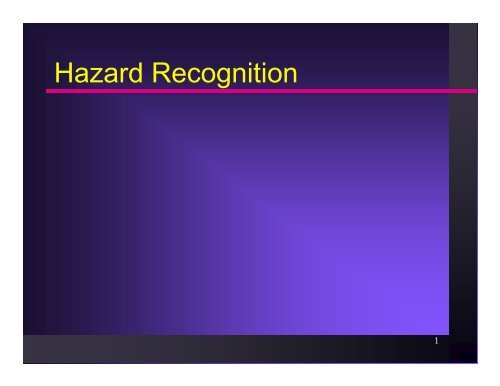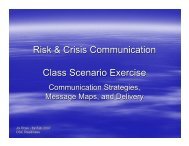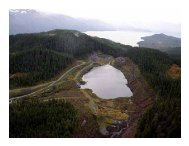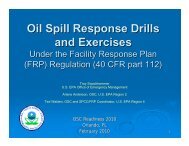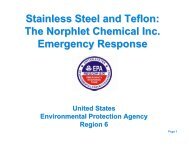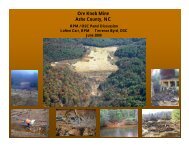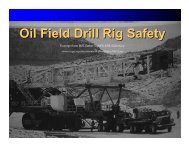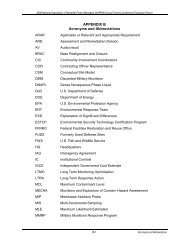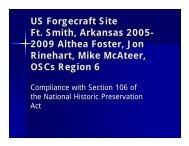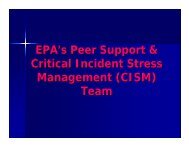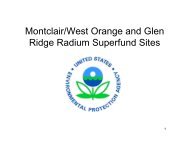Hazard Recognition PowerPoint.pdf
Hazard Recognition PowerPoint.pdf
Hazard Recognition PowerPoint.pdf
Create successful ePaper yourself
Turn your PDF publications into a flip-book with our unique Google optimized e-Paper software.
<strong>Hazard</strong> <strong>Recognition</strong><br />
1
Introduction<br />
• The primary goal of an<br />
inspection program can<br />
be simply stated as: "The<br />
proactive elimination of<br />
accident and illness<br />
causes through specific,<br />
methodical procedures.”<br />
2
Introduction<br />
• The general purpose of conducting<br />
inspections includes more specific<br />
objectives that should be addressed.<br />
These are:<br />
reveal the need for specific safeguards<br />
check results against plan<br />
re-evaluate safety standards<br />
note and act upon unsafe behavior trends<br />
measure safety performance<br />
3
Preliminaries<br />
• assess the operations to<br />
define those unsafe acts and<br />
conditions that can cause<br />
accidents and injuries<br />
• decide which of these are<br />
capable of producing the<br />
greatest damage<br />
4
Department <strong>Hazard</strong> Analysis<br />
• machinery and equipment<br />
• operations<br />
• personnel<br />
5
Inspection System<br />
Requirements<br />
• An effective safety inspection system<br />
requires:<br />
an understanding of the hazards inherent<br />
to the operations and the established work<br />
procedures and safety rules and the basic<br />
requirements of standards and regulations<br />
a series of systematic inspection steps<br />
a method of reporting, evaluating, and<br />
using the data gathered<br />
6
Unsafe Conditions and<br />
Actions to Consider<br />
• materials and substances<br />
used in production processes<br />
• machines, material handling<br />
equipment, tools, etc., used<br />
during manufacturing<br />
• personal protective and safety<br />
equipment must exist<br />
7
Unsafe Conditions and<br />
Actions to Consider<br />
• walking and working surfaces,<br />
(stairs, ladders scaffolds,<br />
ramps, etc.) must be<br />
adequately designed<br />
• illumination, ventilation, noise<br />
generation, fires protection<br />
equipment, etc., must be<br />
properly installed, used within<br />
design limits, and maintained<br />
in a safe manner<br />
8
Unsafe Conditions and<br />
Actions to Consider<br />
• attention to sanitation, housekeeping,<br />
waste disposal, food handling,<br />
material storage<br />
• work methods must conform to<br />
approved methods and safe practices<br />
• medical services, first aid facilities,<br />
and emergency personal protective<br />
devices must be available and of<br />
adequate quality<br />
9
Recognizing Accident Types<br />
• STRUCK BY: this accident<br />
type occurs when an object<br />
strikes an employee<br />
employee hit by unguarded<br />
mechanical equipment<br />
employee hit by falling or<br />
discharged object<br />
employee hit by forklift or other<br />
material handling equipment<br />
10
Recognizing Accident Types<br />
• STRUCK AGAINST: this<br />
accident type occurs when<br />
an employee strikes against<br />
an object<br />
a hand tool slips, and the<br />
employee's hand hits a<br />
machine<br />
An employee working in close<br />
quarters hits head against a<br />
low overhead beam<br />
11
Recognizing Accident Types<br />
• CONTACT WITH: an employee<br />
comes in contact with a harmful<br />
material<br />
Quality Assurance employee<br />
splashes acid on unprotected arm<br />
employee comes in contact with a<br />
hot mold<br />
12
Recognizing Accident Types<br />
• CAUGHT ON: an employee<br />
or part of their clothing or<br />
equipment is caught on an<br />
object that is either moving<br />
or stationary<br />
employee catches clothing<br />
on an unguarded, rotating<br />
shaft or coupling.<br />
employee catches clothing or<br />
hairnet on a protruding bolt<br />
13
Recognizing Accident Types<br />
• CAUGHT BETWEEN: an employee is<br />
crushed, pinched, or otherwise caught<br />
between either a moving object and a<br />
stationary object or between two moving<br />
objects<br />
employee's hand is lacerated or<br />
crushed while reaching into a point of<br />
operation to clear a jam<br />
employee's hand is crushed between<br />
an unguarded V-belt and sprocket<br />
employee loses control of a pallet<br />
jack and is caught between a wall<br />
and the handle<br />
14
Recognizing Accident Types<br />
• FOOT LEVEL FALL: when<br />
an employee slips or trips<br />
and falls on the level they<br />
were walking or standing on:<br />
employee slips on loose<br />
material on floor<br />
employee steps in an<br />
unprotected drain in the floor<br />
15
Recognizing Accident Types<br />
• FALL TO BELOW: this<br />
accident type occurs at level<br />
below the one they were<br />
walking or standing<br />
an employee falls through an<br />
unguarded opening<br />
an employee falls from a scaffold<br />
16
Recognizing Accident Types<br />
• OVER EXERTION: when an<br />
employee over-extends or<br />
strains while doing a job<br />
employee strains back by<br />
lifting an awkwardly shaped<br />
box<br />
employee suffer tendonitis by<br />
not following established case<br />
pack work practices<br />
17
Recognizing Accident Types<br />
• HEALTH EXPOSURE: when an<br />
employee is exposed to harmful<br />
materials or conditions<br />
sanitation employees are overexposed<br />
to hazardous mists, fumes,<br />
dust or vapor<br />
employees are over-exposed to<br />
excessive noise<br />
18
Recognizing Accident Types<br />
• OTHER: this accident type covers any<br />
other exposures not covered by the<br />
above categories.<br />
19
Types of Inspections<br />
• Planned Safety Inspections<br />
deliberate<br />
thorough<br />
systematic<br />
• Continuous Safety Inspections<br />
conducted by employees and line<br />
managers that is incidental to the job<br />
when employees note and report<br />
unsafe conditions and line manager<br />
takes corrective action<br />
20
Planned vs. Continuous<br />
• Both types of inspections have<br />
advantages and disadvantages.<br />
Therefore both are necessary.<br />
21
Inspections<br />
• Where to Inspect<br />
packaging<br />
processing areas<br />
warehouse<br />
forklifts<br />
22
Inspections<br />
• Determine What to Inspect<br />
tools<br />
machines<br />
supplies<br />
equipment<br />
specific operations<br />
compliance issues<br />
• Each of the items may need to be<br />
subdivided<br />
23
Inspections<br />
• Determine What Conditions to Inspect For<br />
• Frequency of Inspection<br />
• Reporting and Follow-Up<br />
follow-up is critical<br />
24
Categories of Inspections<br />
• General<br />
• Special<br />
who should inspect<br />
how to inspect*<br />
25
<strong>Hazard</strong> Classification<br />
• class A<br />
• class B<br />
• class C*<br />
26
Evaluating Inspection Design<br />
• does it specify areas to be inspected<br />
• does it establish inspection frequency<br />
• does it specify who conducts inspection<br />
• does it provide systematic procedures<br />
• does it provide format for reporting<br />
• does it provide adequate follow-up<br />
• does it provide information for effective<br />
management decision making<br />
27
Activity<br />
28


